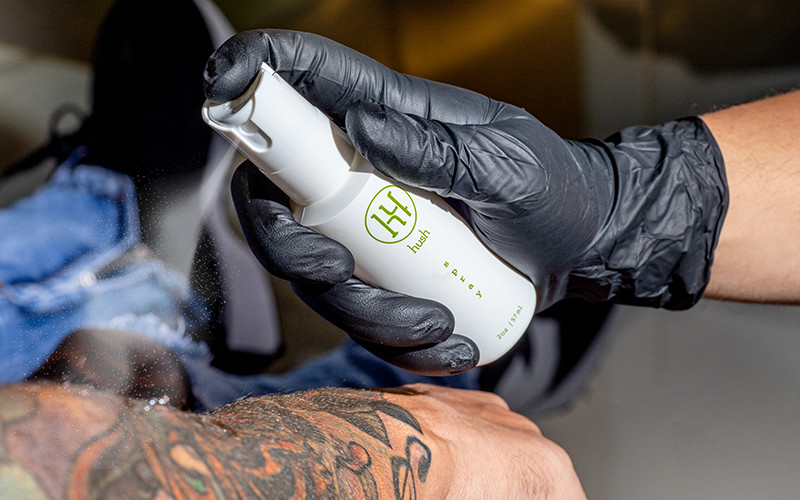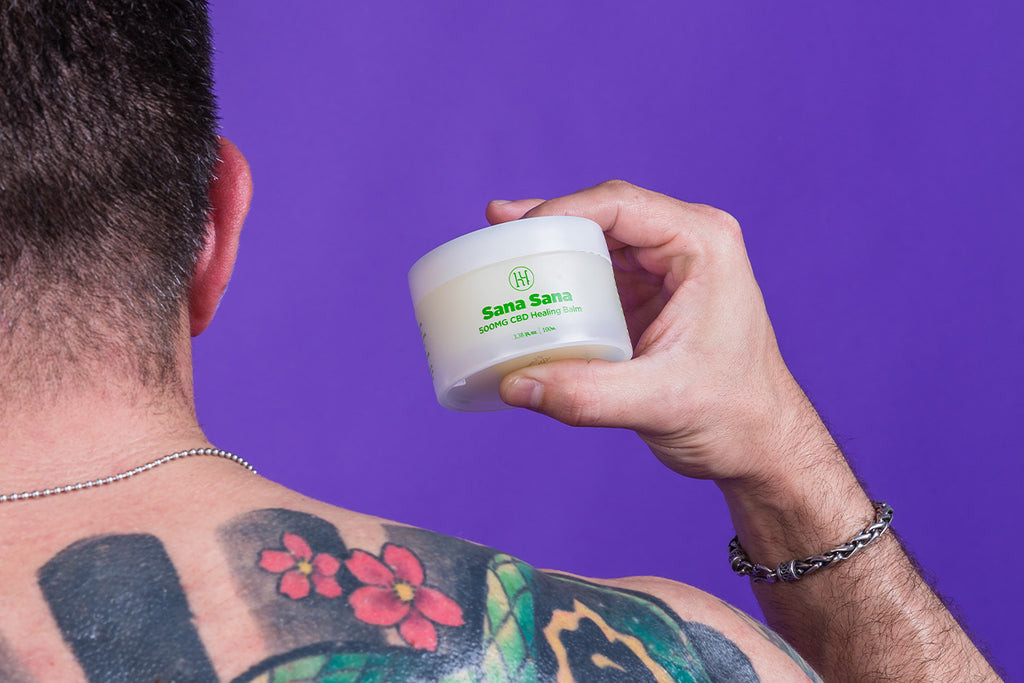Is It Ok To Peel Your Tattoo? Absolutely not! Peeling is a natural part of the tattoo healing process, but resist the urge to pick at it. At tattooat.com, we provide expert advice on tattoo aftercare, ensuring your body art heals beautifully and remains vibrant for years to come. By avoiding picking, you’ll prevent damage and maintain your tattoo’s integrity, color and boldness.
1. What is Tattoo Peeling and Why Does It Happen?
Tattoo peeling is a common phase in the tattoo healing journey. It’s your body’s way of shedding the damaged top layer of skin, revealing the newly tattooed skin underneath.
When you get a tattoo, the needles inject ink into the dermis, which is the layer of skin beneath the epidermis. As the epidermis heals, it naturally exfoliates, causing the peeling. According to research from Portland State University’s Art Department, in July 2023, understanding this process can ease anxiety and promote better aftercare. This exfoliation is essential for the tattoo to fully integrate into your skin.
2. Normal Peeling vs. Bad Peeling: How to Tell the Difference?
Distinguishing between normal and abnormal tattoo peeling is key to ensuring proper healing and preventing complications.
2.1. Normal Tattoo Peeling
Normal peeling is typically characterized by:
- Light Flaking: Similar to peeling after a sunburn, the skin flakes off in small, thin pieces.
- Timing: Usually begins around the end of the first week and lasts for about a week.
- Appearance: Flakes may contain tiny bits of color (stained dead skin).
- Symptoms: Mild itching is normal.
2.2. Abnormal Tattoo Peeling
Bad peeling indicates potential problems like infection or an allergic reaction. Signs include:
- Intense Peeling: Accompanied by redness, swelling, and heat.
- Discharge: Pus or oozing from the tattooed area.
- Pain: Excessive or worsening pain.
- Thick Scabs: Scabs that appear to be pulling away from the tattoo.
- Unpleasant Smell: Any foul odor emanating from the tattoo.
If you notice any of these signs, consult your tattoo artist or a healthcare professional immediately.
3. Is It Okay to Peel Your Tattoo? The Dangers of Picking
It’s crucial to resist the urge to peel your tattoo. Picking or pulling at the peeling skin can lead to several complications that can damage your tattoo.
3.1. Damage from Tattoo Peeling
Picking at your tattoo can result in:
- Uneven Healing: Premature removal of skin can disrupt the healing process, leading to patchy or faded areas.
- Scarring: Picking can cause deep scabs to form, increasing the risk of permanent scarring.
- Infection: Removing skin before it’s ready creates an open wound, making it easier for bacteria to enter and cause an infection.
3.2. Risk of Infection
Infection is a significant concern when you interfere with the natural healing process. According to the Cleveland Clinic, signs of an infected tattoo include:
- Increased Pain and Tenderness: Beyond normal soreness.
- Redness and Swelling: Worsening over time.
- Pus or Drainage: Yellow or greenish discharge.
- Fever or Chills: Systemic symptoms indicating the infection has spread.
If you suspect an infection, seek medical attention promptly.
3.3. The Need for Touch-Ups
Damaging your tattoo by peeling can necessitate touch-ups to correct unevenness or fading. While some artists offer free touch-ups, this may not be the case if the damage is due to improper aftercare.
4. What To Do When Your Tattoo Is Peeling: The Dos and Don’ts
Proper aftercare is essential to managing the peeling phase and ensuring your tattoo heals correctly.
4.1. Washing Your Tattoo
Keep your tattoo clean by gently washing it with mild, fragrance-free soap and warm water. Washing removes bacteria and debris that can hinder healing.
4.2. Moisturizing Your Tattoo
Apply a thin layer of tattoo aftercare cream or fragrance-free lotion to keep the skin moisturized. Hydrated skin is more flexible and less likely to crack or develop thick scabs. tattooat.com recommends using products specifically formulated for tattoo aftercare to promote optimal healing.
 moisturizing tattoo
moisturizing tattoo
4.3. Soothing Itchiness
Itchiness is a common symptom during the peeling phase. Avoid scratching, as this can damage the tattoo. Instead, try:
- Applying a Cold Compress: A cool compress can help relieve itching and inflammation.
- Using a Numbing Spray: Products like HUSH Tattoo Numbing Spray can provide temporary relief from itching and discomfort.
4.4. Protecting Your Tattoo
Protect your tattoo from:
- Sun Exposure: Sunlight can fade and damage new tattoos. Apply sunscreen (SPF 30 or higher) after the tattoo has fully healed.
- Tight Clothing: Wear loose-fitting clothing to avoid rubbing and irritation.
5. The Tattoo Peeling Timeline: What to Expect
Understanding the typical tattoo peeling timeline can help you manage your expectations and ensure proper care.
5.1. Week 1
- Initial Healing: The tattoo may be red, swollen, and tender.
- Peeling Begins: Around day 5-7, the skin starts to flake and peel.
5.2. Week 2
- Continued Peeling: Peeling continues, and scabs may form.
- Itchiness: Itchiness is common during this phase.
5.3. Week 3-4
- Reduced Peeling: Peeling gradually decreases.
- Final Healing: The tattoo should look brighter and more defined as the new skin emerges.
6. Tattoo Aftercare Products: What to Use and Why
Choosing the right aftercare products can significantly impact the healing process.
6.1. Cleansers
Use a mild, fragrance-free soap to keep the tattoo clean. HUSH CBD Foam Soap is an excellent option, as it cleanses gently while providing antibacterial benefits.
6.2. Moisturizers
Select a tattoo aftercare cream or lotion that is:
- Fragrance-Free: To avoid irritation.
- Hypoallergenic: To minimize the risk of allergic reactions.
- Non-Comedogenic: To prevent clogged pores.
6.3. Balms
Tattoo balms can provide a protective barrier and promote healing. HUSH CBD Healing Balm contains ingredients that soothe and nourish the skin.
 tattoo balm
tattoo balm
7. What to Avoid During Tattoo Peeling: A Comprehensive Guide
To ensure your tattoo heals properly, avoid the following:
- Picking or Scratching: As mentioned earlier, these actions can cause significant damage.
- Sun Exposure: Protect your tattoo from the sun to prevent fading and damage.
- Soaking in Water: Avoid swimming, baths, and prolonged showers, as excessive moisture can interfere with healing.
- Tight Clothing: Wear loose-fitting clothes to minimize friction and irritation.
8. Is My Tattoo Peeling or Infected? Recognizing the Signs
Knowing the difference between normal peeling and infection is crucial for taking appropriate action.
8.1. Normal Peeling Symptoms
- Light Flaking: Similar to sunburn peeling.
- Mild Itchiness: Manageable with moisturizer or cold compress.
- No Redness or Swelling: Limited to the initial days after getting the tattoo.
8.2. Infected Tattoo Symptoms
- Increased Pain and Tenderness: Worsening over time.
- Excessive Redness and Swelling: Spreading beyond the tattooed area.
- Pus or Drainage: Yellow or greenish discharge.
- Fever or Chills: Systemic symptoms indicating infection.
If you experience any signs of infection, seek medical attention immediately.
9. Tattoo Styles and Peeling: Does it Vary?
The extent of peeling can vary depending on the tattoo style and the artist’s technique.
9.1. Fine Line Tattoos
Fine line tattoos may experience less peeling than bold, heavily saturated designs. The limited ink volume means less trauma to the skin.
9.2. Traditional Tattoos
Traditional tattoos, with their bold lines and solid colors, may experience more noticeable peeling due to the larger ink deposits.
9.3. Black and Grey Tattoos
Black and grey tattoos can vary in peeling based on the saturation levels. Heavily shaded areas may peel more than lightly shaded ones.
10. The Importance of Following Tattoo Artist Instructions
Your tattoo artist is your best resource for aftercare advice. They can provide specific instructions based on your skin type, the tattoo’s design, and the products they recommend.
10.1. Aftercare Guidelines
Always follow your tattoo artist’s aftercare guidelines, including:
- Washing Frequency: How often to clean the tattoo.
- Moisturizing Recommendations: Which products to use and how often to apply them.
- Bandaging Instructions: When to remove the bandage and whether to re-bandage the tattoo.
10.2. Contacting Your Artist
Don’t hesitate to contact your tattoo artist if you have any concerns or questions about the healing process. They can assess your tattoo and provide guidance on how to proceed.
11. Tattoo Peeling and Skin Types: What to Consider
Your skin type can influence how your tattoo heals and peels.
11.1. Dry Skin
People with dry skin may experience more noticeable peeling and itchiness. It’s essential to keep the tattoo well-moisturized to prevent cracking and discomfort.
11.2. Oily Skin
Oily skin may experience less peeling, but it’s still important to follow proper aftercare procedures. Choose non-comedogenic moisturizers to prevent clogged pores.
11.3. Sensitive Skin
If you have sensitive skin, opt for hypoallergenic and fragrance-free aftercare products to minimize the risk of allergic reactions.
12. Tattoo Touch-Ups: When Are They Necessary?
Touch-ups may be necessary if your tattoo experiences:
- Fading: Loss of color intensity.
- Patchiness: Uneven ink distribution.
- Scarring: Raised areas due to improper healing.
Most tattoo artists recommend waiting at least a month after the initial tattooing before considering a touch-up. This allows the skin to fully heal and stabilize.
13. Tattoo Peeling Myths Debunked
There are many misconceptions about tattoo peeling. Let’s debunk some common myths:
- Myth: Peeling means the tattoo is ruined.
- Fact: Peeling is a normal part of the healing process and doesn’t necessarily mean the tattoo is damaged.
- Myth: You should scrub the tattoo to remove peeling skin.
- Fact: Scrubbing can damage the tattoo and increase the risk of infection.
- Myth: If your tattoo doesn’t peel, it’s not healing correctly.
- Fact: Not everyone experiences noticeable peeling. As long as there are no signs of infection, the tattoo is likely healing fine.
14. Frequently Asked Questions (FAQs) About Tattoo Peeling
Here are some frequently asked questions about tattoo peeling:
14.1. How Long Does Tattoo Peeling Last?
Tattoo peeling typically lasts for about a week, starting around the end of the first week after getting the tattoo.
14.2. Is It Normal for My Tattoo to Itch During Peeling?
Yes, itchiness is a common symptom during the peeling phase.
14.3. Can I Use Regular Lotion on My Peeling Tattoo?
It’s best to use fragrance-free and hypoallergenic lotion specifically designed for tattoo aftercare.
14.4. What Happens if I Accidentally Peel Off a Piece of Skin?
Gently clean the area and apply a thin layer of moisturizer. Avoid picking at it further.
14.5. How Can I Speed Up the Tattoo Healing Process?
Follow proper aftercare procedures, including keeping the tattoo clean and moisturized.
14.6. Can I Exercise While My Tattoo Is Peeling?
Avoid strenuous activities that cause excessive sweating, as sweat can irritate the tattoo.
14.7. What Should I Do if My Tattoo Starts to Swell or Ooze?
See a doctor immediately, as these are signs of infection.
14.8. Can I Get My Tattoo Re-Done if It Doesn’t Heal Properly?
Yes, touch-ups can correct any imperfections or fading.
14.9. Is It Okay to Cover My Peeling Tattoo With a Bandage?
Avoid covering the tattoo with a bandage unless specifically instructed by your tattoo artist, as it needs air to heal properly.
14.10. How Soon Can I Get Another Tattoo After My First One Heals?
It’s generally recommended to wait at least two weeks to a month after your tattoo has fully healed before getting another one.
15. Conclusion: Embrace the Healing Process
Tattoo peeling is a normal and temporary phase in the tattoo journey. By understanding what to expect and following proper aftercare procedures, you can ensure your tattoo heals beautifully and remains a vibrant piece of art for years to come. Remember, patience and diligence are key to achieving the best results.
At tattooat.com, we’re dedicated to providing you with the knowledge and resources you need to care for your tattoos properly. Explore our website for more in-depth guides, product recommendations, and expert advice.
Ready to take your tattoo care to the next level? Visit tattooat.com today to discover a wealth of inspiration, connect with talented artists, and gain the knowledge you need to keep your ink looking its best. Start your journey now and ensure your tattoos remain a vibrant reflection of your unique style!
Contact Information:
Address: 1825 SW Broadway, Portland, OR 97201, United States
Phone: +1 (503) 725-3000
Website: tattooat.com
